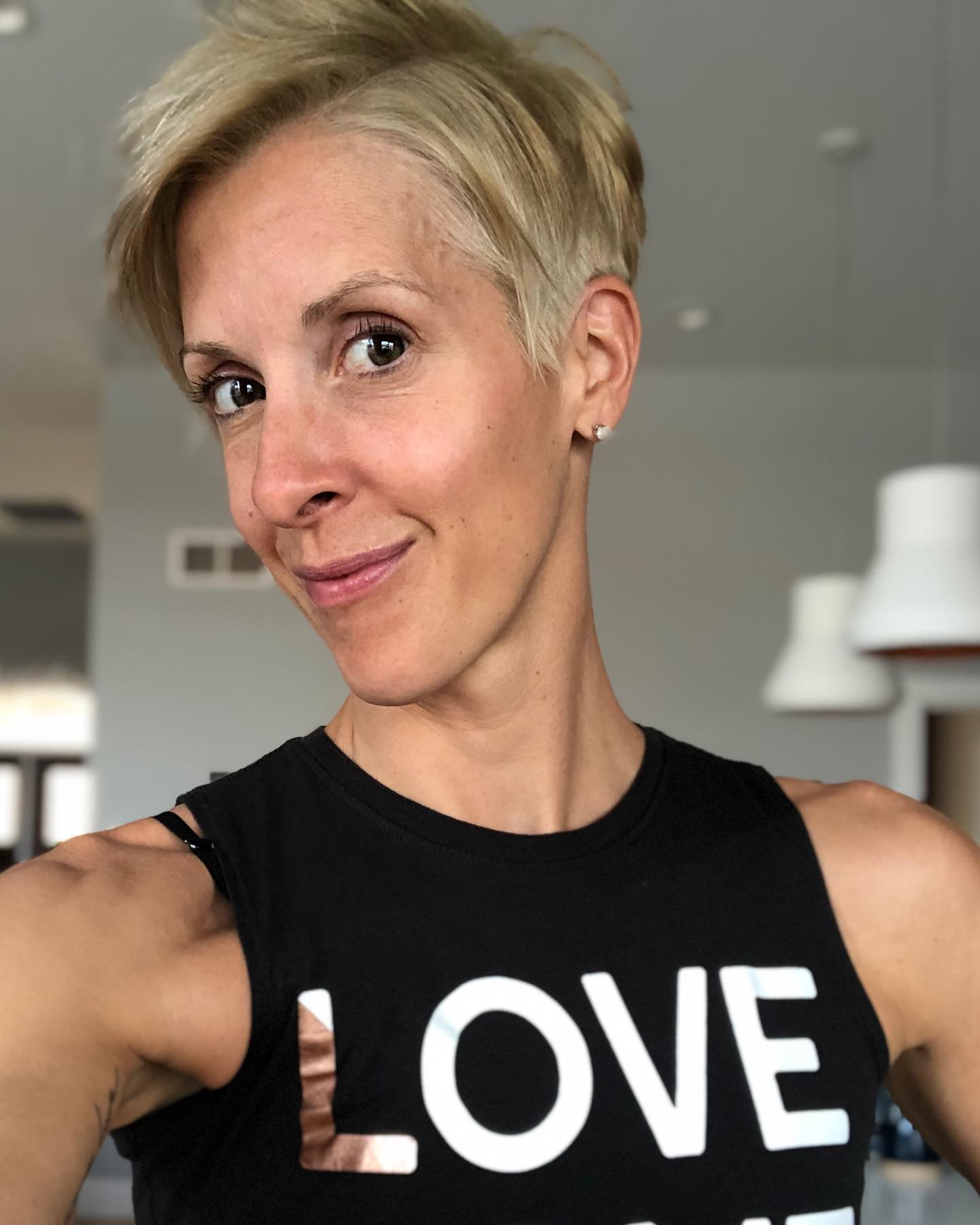
It’s (Not) Just Hair
Feb 24, 2022Should you shave your bikini line before a ride? How do you protect your hair against chorine & sun damage? Afros & helmets? Hair poses unique challenges for women when it comes to training for triathlon. Here’s how to keep your hair happy & healthy while swimming, biking & running.
Text by Miranda Bush, Feisty Triathlon Head Coach & Educator
I recently made the bold move to bleach my hair to platinum blonde and chop it off to a short and spunky pixie. I enjoy making big changes, and I have always taken on the attitude that “it’s just hair.”

But after some more thoughtful consideration, I identified that one of the reasons that I “needed a big change” was because I like inspiring women to believe that they too can make choices to alter physical appearance based on their own wants. I reflected on what I already knew–it is not just hair. Hair is not only a part of our appearance but it also has many different cultural ties around the world. Some studies also point to longer, healthier hair as being an indicator of youth for women.
Anyone who’s played a sport knows that the hair on your head isn’t just an accessory. The way you wear it can either help or hinder your performance, give you confidence to do your best, or even spark controversy. Women of color have unique cultural connections to hair, as well as different needs in equipment. In fact, it was found that between 28-45% of Black women surveyed for a 2018 Frontiers in Public Health study avoided exercise because of hair concerns.
For all women triathletes, it can be a struggle to maintain healthy hair with the rigors of the elements and equipment of three different sports. And at the same time we are bombarded with the message that we should get rid of (basically all of) our body hair. Not only is it difficult to decipher the truth on that matter, but removing it presents its own challenges.
Removing Unwanted Hair
What you do with your body hair is your personal choice, yet (as with most decisions) it can be heavily affected by the conflicting messaging we receive. We are encouraged to remove some of our (outward facing) body hair to be faster athletes and some hidden hair to be “more hygienic” as women. But there are risks with removing hair, especially pubic hair. So what do triathletes do with all of our hair?
The Arguments for Removing Body Hair
There are several reasons that triathletes may want to remove leg (and even arm) hair. Cyclists cite removing body hair to be able to treat wounds easier (like road rash, etc) or to create ease with massages and other conveniences of training.
“Shaving down” in the swim world also seems to provide psychological benefits. The ritual is part of a conditioned response—the camaraderie and process signals the brain to prepare for competition. Athletes claim to feel faster in the water.
But are there actual performance benefits to removing body hair? Swim studies generally state that shaving or waxing does reduce drag while increasing performance, but the evidence is inconclusive for the actual amount of energy saved. A Specialized bike wind tunnel study showed that shaving the test subject's legs reduced drag by about 7%, saving 15 watts at the same speed. In theory, that translates to a 79-second advantage over a 40-kilometer time trial.
So, there are proven scientific benefits to going hairless. It is up to you to weigh the benefits to any perceived drawbacks and make a choice that serves you best as a competitor. Coach tip: When deciding whether or not to remove body hair for the swim portion benefits, don’t forget to consider if you will be wearing a sleeved or sleeveless wetsuit!
When and How to Remove Pubic Hair (or Not?)
According to a recent study, more than 50% of young women (18–24 years old) in the U.S. said they removed pubic hair recently. Most women remove pubic hair for sexuality or aesthetic reasons, often because they believe it’s more hygienic or cleaner.
There are risks associated with hair removal, whether shaving or waxing, with no actual data to show improved genital health from removing pubic hair. Risks can include genital burns, severe skin irritation leading to post inflammatory hyperpigmentation, or vulvar and vaginal irritation and infections. Less serious complications that may be experienced as a result of pubic hair removal include: epidermal abrasion, ingrown hairs, folliculitis, vulvitis, contact dermatitis, or saddle sores, common in female cyclists and triathletes. Hair removal can also increase chafing on the labia.
This isn’t a blog about how you should refrain from removing pubic hair. Your hair is your business. For those who want to groom, trimming carefully with scissors or a trimmer is most likely the healthiest and safest option. Be mindful of the type and time of hair removal surrounding your vulva. Many female coaches and athletes suggest not shaving your bikini line and vulva area within 48-72 hours before a long ride. Hair protects the skin as a barrier to friction, creating less potential for chafing, saddle sores, ingrown hairs, and infections. Check out some more shaving and waxing hair removal tips for women who ride bikes here.
Care for the Hair on Your Head
As triathletes, the hair on our head is greatly affected by chlorine, sun, sweat, wind, saltwater, and even our equipment. No matter if you choose to keep your hair long, short, full of volume, or even shaved close to your head (or completely), there are ways to care for your hair and/or scalp.
Tips for Protecting your Hair:
In the Swim:
- Before you swim, rinse your hair thoroughly with clean water for a few minutes. Provide a barrier with a hydrating conditioner (such as one that contains dimethicone) to coat your hair strands.
- As soon as you are out of the pool, wash your hair thoroughly with a clarifying shampoo and rinse it with clean water. Follow up with a hydrating conditioner. If you don’t wash and rinse, the chemicals from the pool can dry out and crack your strands all day long. Check out TRIHARD for a full line-up of pre and post-swim hair & skin care products.
- Seek out a comfortable swim cap. If you've been using latex caps, try a silicone or even a LYCRA® one. They're made of softer material and may not pull your hair as much. Some swimmers even layer a rubber cap over a LYCRA® one. The LYCRA® cap easily contains their hair and makes it easier to put on the latex or silicone cap. If you have hair “blessed by volume” check out Soul Cap (a company with a mission for inclusivity in swimming). They have great options that have been designed for those with dreadlocks, weaves, hair extensions, braids, and thick and curly hair.
On the Bike:
- Check out this video from a skater, or this article from a bike rider for tips on how to fit afro hair in a helmet.
- Wear a bandana, or some kind of head scarf under your helmet to protect from friction breaking your hair and also from sun damage. This protects your scalp as well!
- Braid or tie your long hair up in a low bun to help prevent tangles and breakage.
On the Run
- Wear a comfortable hat, for the same reasons mentioned above.
- Be mindful that tight headbands, hair ties, or other accessories can cause breakage if it is pulling your hair back in an extreme way.
- Professional Black runners also suggest taking time to learn more about your hair, be careful about over cleansing, and avoiding humidity when possible for women of color.
General hair care:
- In general, be mindful of the hair products you use before training. When you sweat certain products may run into your eyes and cause burning, stinging, or other discomfort.
- Check out this short podcast on remaining true to you, and the importance of representation in all aspects of triathlon–including hair care!
It is your hair and so where you remove it and where you choose to let it grow is always up to you. As always, make the choices that honor your priorities, cultural values, and interests as an athlete as well as in the other roles in your life.
It is (or not) just hair.

Miranda Bush is the Head Coach and Educator at Feisty Triathlon. She is USA Triathlon and Training Peaks certified, as well as a certified Health Coach. She is also a graduate of Dr. Stacy Sim’s Women Are Not Small Men and Menopause for Athletes courses. As a longtime coach specializing in training women, her passion lies in using lessons from training and racing to teach athletes to evolve physically, mentally, and emotionally through sport. Miranda is also a longtime athlete and multiple Ironman and 70.3 distance podium finisher, maintaining a consistent racing career while working and raising her kids. She resides in Wisconsin with her three teenagers and husband who all love to race triathlon.
Get Feisty Triathlon straight to your inbox
Get the low-down on what's happening in the world of women's triathlon, tips & tricks to crush it on the race course and be the first to know about special offerings from our feisty sponsors.
We hate SPAM. We will never sell your information, for any reason.

